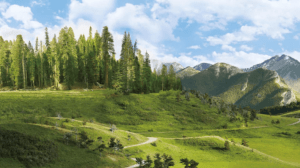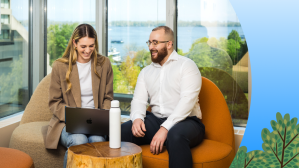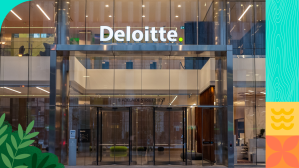Forests, which are critical to the health of our planet, covered about half the Earth before the agricultural revolution began. In the 8,000 years since, while we’ve managed to feed and house billions of people, we’ve also lost or degraded half of those forests, fueling a biodiversity collapse and the climate crisis. It’s time we stop taking from our natural ecosystems, and start giving back.
In January, as a founding partner of 1t.org, and in support of its mission, Salesforce announced our goal to support and mobilize the conservation, restoration, and growth of 100 million trees by the end of 2030. We do so for humans and other life on this planet, to help mitigate climate change, to improve livelihoods, and so much more.
But we know we can’t do it alone. We teamed up with Global Forest Generation (GFG) to grow forests in South America. In 2020, we are supporting the ambitious reforestation project Accion Andina to plant over one million native trees and protect forests with local communities and NGOs across the Andes mountains of Peru, Ecuador, Bolivia, Chile and Argentina.
We caught up with Florent Kaiser, Executive Director at GFG, to better understand his organization’s role in the reforestation process and learn how partnerships and innovation can help us restore the planet with Nature Based Solutions.
Q. Can you tell us about GFG? What’s the organization’s mission and what is your role?
We’re a new group with an old soul. We formed GFG to help overcome some of the biggest obstacles to global forest restoration: The world wants to plant a trillion trees, but there are too few good projects, too little capacity on-the-ground, not enough long-term commitment, and the few local leaders that truly know how to engage their communities to restore their lands do not have the resources and partnerships to do so.
GFG works very closely with these local leaders and the communities they work with. We connect the best forest projects across entire ecosystems and equip them with everything they need to sustain and grow their impact. My role is to connect our local project partners to governments, multilaterals, corporations and global initiatives such as 1t.org that can bring the technology, the resources, the political support and the momentum to scale them up.
Q. What can you tell us about your partnership with Salesforce for the Acción Andina project?
Acción Andina is one of the most exciting forest restoration initiatives in the world today. The Andes in South America are an almost 4,000 miles long habitat spanning across seven countries. They are the source of freshwater for millions of people in South America, and the headwaters of the Amazon rainforest. However, once covered by lush forests, they have been almost entirely deforested in the past 500 years.
Climate change is melting Andean glaciers away, causing serious threats to water security in the region. The only natural substitute to them are forests. Accion Andina works with local partners and communities to bring them back.
As an early investor, Salesforce’s support allowed us to lift our impact from 150,000 trees planted in 2018 when we started, to over 1.2 million trees this year. Accion Andina’s goals are to plant more than 10 million trees in the next 5 years and 100 million in the next 25 years. Salesforce will not only contribute with resources and technology to make this happen, but through the partnership we will work together to motivate other major corporations and global leaders to invest and bring back forests where they are needed most.
Q. What are the main obstacles to scaling global restoration?
That is hard to answer briefly as the challenges are complicated and different depending on the restoration arena. At the project level, there are too few quality projects “shovel ready”, too little planning for what happens after the trees are planted, and too few dedicated leaders on-the-ground equipped with the support and resources needed to succeed. At the global thought-leader level there is a disconnect from on-the-ground restoration efforts which hinders global planning, implementation, and impact. One of the aims of the GFG and Salesforce partnership is to bridge these two worlds to overcome the main obstacles.
And then, there is also a mindset and prioritization issue. Scientists took decades to make the case on why we need forests. What we now need is a new generation of entrepreneurs who take their wisdom to set up the operations, logistics, relationships and leadership to implement at an unprecedented scale.
Q. Walk us through the processes of growing, conserving and restoring trees from planning to planting and what happens afterwards.
Making large scale forest restoration projects work is not an easy task. You are dealing with thousands of communities, all with different rules and cultural particularities. Local leadership, engagement and trust are key. One of the most fundamental starting points is to understand the local needs and wishes of local people, then to find ways to meet community resource needs that allow forests to grow sustainably.
Next is planning and building. We work with scientists, conservationists and experienced practitioners to piece the parts together: from ecological mapping, to project scoping, economic modelling, legal analysis, projections for logistics, budgeting, setting up monitoring systems, and so much more. Training, planning and replanning never ends, and needs to be constantly fine-tuned.
Then implantation. Our restoration projects include protection of existing forests in addition to reforestation. So the first step is site selection, and one of the key criteria is to have an existing mature forest nearby from which seed and cuttings can be obtained.
To grow trees in the Andes, we start between January to March connecting our local partners and with the communities to build or expand on-site tree nurseries. From April to November, families take turns caring for the seedlings until they are ready to be transplanted.
Generally starting in December, at the beginning of the Andean rainy season, is when we plant. In Peru, where ancient Inca traditions are still an important part of daily life, indigenous communities celebrate planting with festivals that can draw up to 1,000 villagers across multiple generations to work together and plant up to 100,000 trees in a single day. Acción Andina aims to replicate such collaborative and cost-effective practices throughout the Andes to mobilize the workforce needed to bring back forests at a massive scale.
I encourage anyone interested in seeing this part of the reforestation projects Salesforce is helping to support to check out this video: https://www.youtube.com/watch?v=pyUO9mLvM-Q
Long-term care is provided by the communities themselves, such as fencing and irrigation, as it is their wish to bring the forests and water back.
Q. How can technology’s ability to connect people play a role in the success of 1 trillion trees?
There are currently three trillion trees on the planet. Regrowing an additional one trillion trees represents a massive task, and we need everybody involved to succeed. First, we need better information and data to know where, how, when, with whom these trees can be grown or naturally regenerate. Remote sensing and increasingly A.I. will support governments, investors, and a large number of implementers better understand potential and assess risk.
We also need technology to better manage large-scale operations such as our work in the Andes. Here, there is a lot the NGO world can learn from successful companies like Salesforce who manage thousands of staff and engage with millions of customers across geographies and markets. Perhaps the most important aspect of technology will be the ability to better tell the stories and connect all parts of general society to engage and support these projects.
Q. Can you talk about the power of building sound partnerships, such as partnerships with companies, and relationships with local communities?
This is a “greater good” moment in human history. Our restoration partnerships sustain because they are united behind an urgent cause and all are given meaningful roles to play, from the person who plants the tree in the ground, to the person who helps fund it. Partnership turns competitors into collaborators, allowing economies of scale and efficiencies we could not achieve otherwise. Our partnership with Salesforce represents this. We hope we can leverage this partnership to bring many other people, investors, governments and companies together.
Q. What are the next innovations, technological advances, and partnerships that you think will help in the battle against climate change?
We must urgently get to a post fossil-fuel world and adopt regenerative principles across all our industries that not only reduce carbon, but also help put it back into the ground. Decarbonization is key but will require restructuring our entire economies, the way we live and the way we consume resources. COVID-19 is currently teaching us many important lessons. Beyond the truly saddening part of loss and illness, it also shows us that immediate action and prevention is key, and that we can transform our daily routines if we need to. Climate change is already numerous times more impactful than the current crisis. Technology, if anything, needs to accompany and facilitate that transition.



















